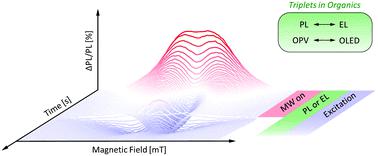当前位置:
X-MOL 学术
›
Mater. Horiz.
›
论文详情
Our official English website, www.x-mol.net, welcomes your feedback! (Note: you will need to create a separate account there.)
Detecting triplet states in opto-electronic and photovoltaic materials and devices by transient optically detected magnetic resonance
Materials Horizons ( IF 13.3 ) Pub Date : 2021-07-30 , DOI: 10.1039/d1mh00999k Jeannine Grüne 1 , Vladimir Dyakonov 1 , Andreas Sperlich 1
Materials Horizons ( IF 13.3 ) Pub Date : 2021-07-30 , DOI: 10.1039/d1mh00999k Jeannine Grüne 1 , Vladimir Dyakonov 1 , Andreas Sperlich 1
Affiliation

|
Triplet excited states in organic semiconductor materials and devices are notoriously difficult to detect and study with established spectroscopic methods. Yet, they are a crucial intermediate step in next-generation organic light emitting diodes (OLED) that employ thermally activated delayed fluorescence (TADF) to upconvert non-emissive triplets to emissive singlet states. In organic photovoltaic (OPV) devices, however, triplets are an efficiency-limiting exciton loss channel and are also involved in device degradation. Here, we introduce an innovative spin-sensitive method to study triplet states in both, optically excited organic semiconductor films, as well as in electrically driven devices. The method of transient optically detected magnetic resonance (trODMR) can be applied to all light-emitting materials whose luminescence depends on paramagnetic spin states. It is thus an ideal spectroscopic tool to distinguish different states involved and determine their corresponding time scales. We unravel the role of intermediate excited spin states in opto-electronic and photovoltaic materials and devices and reveal fundamental differences in electrically and optically induced triplet states.
中文翻译:

通过瞬态光学检测磁共振检测光电和光伏材料和器件中的三重态
众所周知,有机半导体材料和器件中的三重激发态很难用既定的光谱方法检测和研究。然而,它们是下一代有机发光二极管 (OLED) 的关键中间步骤,OLED 采用热激活延迟荧光 (TADF) 将非发射三重态上转换为发射单重态。然而,在有机光伏 (OPV) 器件中,三重态是一种限制效率的激子损耗通道,并且还涉及器件退化。在这里,我们介绍了一种创新的自旋敏感方法来研究光激发有机半导体薄膜以及电驱动器件中的三重态。瞬态光学检测磁共振 (trODMR) 方法可应用于所有发光取决于顺磁自旋态的发光材料。因此,它是区分所涉及的不同状态并确定它们相应的时间尺度的理想光谱工具。我们揭示了中间激发自旋态在光电和光伏材料和器件中的作用,并揭示了电和光诱导三重态的根本差异。
更新日期:2021-08-10
中文翻译:

通过瞬态光学检测磁共振检测光电和光伏材料和器件中的三重态
众所周知,有机半导体材料和器件中的三重激发态很难用既定的光谱方法检测和研究。然而,它们是下一代有机发光二极管 (OLED) 的关键中间步骤,OLED 采用热激活延迟荧光 (TADF) 将非发射三重态上转换为发射单重态。然而,在有机光伏 (OPV) 器件中,三重态是一种限制效率的激子损耗通道,并且还涉及器件退化。在这里,我们介绍了一种创新的自旋敏感方法来研究光激发有机半导体薄膜以及电驱动器件中的三重态。瞬态光学检测磁共振 (trODMR) 方法可应用于所有发光取决于顺磁自旋态的发光材料。因此,它是区分所涉及的不同状态并确定它们相应的时间尺度的理想光谱工具。我们揭示了中间激发自旋态在光电和光伏材料和器件中的作用,并揭示了电和光诱导三重态的根本差异。


























 京公网安备 11010802027423号
京公网安备 11010802027423号